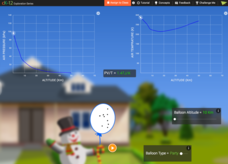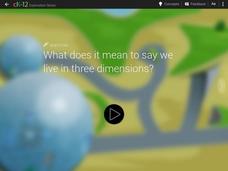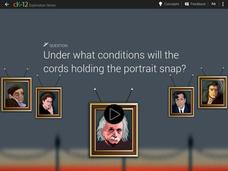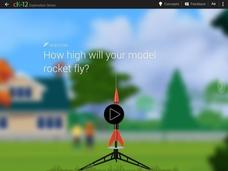CK-12 Foundation
Scuba Training
How does a scuba diver control whether they sink or float? Scholars observe the relationship between absolute pressure and depth below the surface in an undersea simulation. They control the diver size and depth to center of mass to...
CK-12 Foundation
Heat Engine
How can heat power an engine? Scholars observe a heat engine working and control variables to determine the most efficient setup. They change the amount of heat input as well as the stroke length. Energy efficiency numbers prove the...
CK-12 Foundation
Runaway Balloon
When a child lets go of a helium balloon, what happens to it? Does it float all the way to space? The simulator allows pupils to experiment on party balloons and weather balloons under different conditions to see what happens to them in...
CK-12 Foundation
Stow Lake
Does the depth of a pond matter to the waves created when rain is falling? Many people assume the answer is no, but interestingly, it does matter. Pupils explore this concept and other variables related to wave behavior through a...
CK-12 Foundation
Stadium Wave
If you are at a sports match and the crowd starts two waves that are both headed toward you at the same time, what do you do? The simulation applies the concepts of constructive interference and destructive interference to that very...
CK-12 Foundation
Light Wave
Do radio waves create light? It's more difficult to understand the things we can't see than those that we can. The simulation compares the relatively small range of visible light to the entire electromagnetic spectrum. It graphs the size...
CK-12 Foundation
Trampoline
Does a trampoline use mostly potential or kinetic energy? Pupils adjust the mass of the jumper, stiffness of the trampoline, and initial jump height in order to answer that question. The simulation displays graphs of the various types of...
CK-12 Foundation
Rose Colored Glasses
How can we change the color of what we are seeing? The simulation allows individuals to change the color of a car's paint, the color of light pointed at the car, and the color of glasses the person is wearing. Each combination creates a...
CK-12 Foundation
Block and Tackle
Can you easily lift more than your own weight? With a pulley system, almost anyone can manage this challenge. Scholars adjust the mechanical advantage (number of pulleys), weight of object being lifted, and the length of rope pulled. The...
CK-12 Foundation
Cassegrain Telescope
How does a telescope magnify images? Learners first watch a tutorial explaining the basic construction of a telescope. Then they interact with a simulation that allows for changes in the location and diameter of the reflecting mirrors....
CK-12 Foundation
Roller Coaster
Roller coasters rely on both kinetic and potential energy, but how much total energy does a roller coaster need? Scholars vary the mass of a coaster and the height of the initial hill. Graphs showing the types of energy and total energy...
CK-12 Foundation
At the Crossroads
Young scientists investigate methods of comparing standard and metric units with a technology-enhanced lesson that builds a connection between conversion ratios and the corresponding units. The simulation allows learners to...
CK-12 Foundation
Irwin 2D
Learners explore two-dimensional motion through visual modeling with an interactive lesson that allows them to control the path of a robot. Graphs show both the horizontal and vertical motion as the robot continues through its...
CK-12 Foundation
Newton's Cannon
Gravity does more than keep our feet on the ground — it holds a satellite in orbit, too. Help learners understand the effects of gravity on an orbiting object through a simulation activity. Individuals adjust a launch speed and watch as...
CK-12 Foundation
Portrait Gallery
An interactive lesson explores the effect of force angles on resulting forces. Learners adjust angles of strings supporting hanging portraits and watch the effects on the resultant force. Vector diagrams provide a visual representation...
CK-12 Foundation
Tire Pressure
Learners use an interactive simulation to explore the connection between force and air pressure. They adjust the mass of a vehicle and air pressure in its tires and predict the result. As the vehicle's mass increases, the tire pressure...
CK-12 Foundation
Irwin and Ruthie
Learners compare acceleration to displacement through an interactive tutorial that permits them to adjust the running strategy of two robots and watch them race. A graph displays the robot's velocity over time and another shows their...
CK-12 Foundation
Model Rocket
Acceleration, velocity, mass, and gravity all play a role in the motion of a rocket. Young scientists explore the connection among these components using an interactive tutorial. They adjust the mass and thrust force to experiment with...
CK-12 Foundation
Magnifying Glass
How can a magnifying glass or reading glasses make things appear larger? Scholars simulate moving a lens closer or farther from an object to observe the resulting image. They also alter the lens focal length. The simulation shows the...
CK-12 Foundation
Least Time
What is the fastest way to get from point A to point B if you are going through two different mediums, such as air then water? Scholars explore the way light travels through air, water, acrylic, glass, and diamond as they answer this...
CK-12 Foundation
Contact Lens
How do contact lenses work? The simulation allows young scientists to explore focal length and lens type to see how and why contact lenses work. Pupils control the focal length for an eye and a lens, the type of lens, and the distance...
CK-12 Foundation
Diamond Cut
How do jewelers tell the difference between diamonds, glass, and cubic zirconia? A sparkling simulation demonstrates how to use a ray of light to determine the substance and ideal shape for a diamond. Scholars control the material,...
CK-12 Foundation
Flashlight
In a simple circuit, does electricity start instantly? A simulation encourages thinking about the flow of electrons at a microscopic level. Pupils control the voltage, resistance, and switch in order to observe the change in both ideal...
CK-12 Foundation
Flashing Neon Light
How does a neon light work and does it actually contain the gas neon? An enlightening simulation encourages pupils to play with circuits and neon lights. They control the capacitance, resistance, and color of the bulb, and the simulation...























